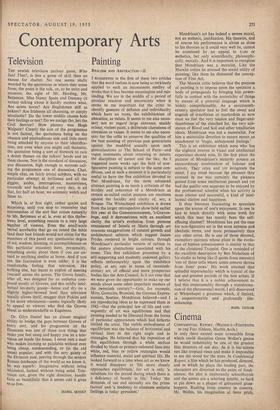REALISM AND ABSTRACTION—II
I SUGGESTED in the first of these two articles that the word realism is now being so recklessly applied to such an inconsistent medley of works that it has become meaningless and mis- leading. We are in the middle of a period of peculiar reaction and uncertainty when it seems to me important for the critic to identify gestures of defiance and individuality which have no roots, the exhibitionism of execution, as values. It seems to me also neces- sary not to regard large canvases, muddy colour, violent paint, a deliberate clumsiness of execution as values. It seems to me also neces- sary for the critic to preserve the qualities of the best painting of previous past generations against the muddled assaults upon such generalisations as The School of Paris—and vague statements about returning to nature, the disciplines of nature and the like. As I suggested some weeks ago the field of non- figurative painting is subject to the same con- ditions, and at such a moment it is particularly useful to have the fine exhibition devoted to Piet Mondriaan, for the most advanced abstract painting is as much a criticism of the lucidity and coherence of a Mondriaan as certain so-called realist pictures are reactions against the lucidity and clarity of, say, a Braque. The Whitechapel exhibition is drawn from the larger retrospective show held earlier this year at the Gemeentemuseum, 's-Graven- hage, and it demonstrates with an excellent clarity the artist's evolution from pictures reminiscent of Israels or Maris through art nouveau exaggerations of natural growth and architectural subjects which suggest James Prydes rendered in bright colours, through Mondriaan's particular version of cubism to the austere abstractions associated with his name. This fine exhibition presented by a self-supporting and modestly endowed gallery reflects unfavourably upon the exhibition policy, at any rate in terms of twentieth- century art, of official and more prosperous bodies like the Arts Council. Is it not time that we were given the opportunity to make up our minds about some other important masters of the twentieth century?—Gris, for example, Miro, Gonzales, Brancusi, the German Expres- sionists, Soutine. Mondriaan believed—and I am reproducing ideas as he expressed them in 1942—that the principal law of life and con- sequently of art was equilibrium and that painting needed to be liberated from the forms of particular appearances which had hitherto limited the artist. The visible embodiment of equilibrium was the balance of horizontal and vertical lines in the right angle and in rectangles. He believed that his exposition of this equilibrium through a white surface divided by black or primary-coloured lines into white, red, blue or yellow rectangles would influence material, social and spiritual life. He looked forward to a time when art as we know it would disappear as 'life more closely approaches equilibrium,' for art is only 'a substitute for the period during which there is a deficiency of beauty in life.' Today 'the demands of use and necessity are the prime factors' and 'a tendency to eliminate esthetic feelings is today prevalent.
Mondriaan's art has indeed a severe moral, not an esthetic, justification. His theories, and of course his performance is about as close to his theories as it could very well be, cannot be countered by an appeal to taste or esthetics, but only scientifically, philosophi- cally, morally. And it is important to recognise that Mondriaan was a moralist. Like the Marxist critics he stressed the social utility of painting; like them he distrusted the concep- tion of Fine Art.
The Marxist critic believes that the purpose of painting is to impose upon the spectator a body of propaganda by bringing him power- fully in contact with the materiality of things by means of a pictorial language which is widely comprehensible. As a seventeenth- century spectator had to feel the sweat and anguish of crucifixion or martyrdom so now must we feel the very tension and finger-and- thumbiness of the clenched fist, the very sub- stance of Blood and Soil and other totalitarian ideals. Mondriaan was not a materialist. For him a materialist devotion to nature meant an attachment to 'tragic, unbalanced feelings.'
This is an exhibition which none who has the slightest interest in visual and intellectual experience should miss. In the first place the pictures of Mondriaan's maturity possess an extraordinary combination of balance and activity. They relax and yet invigorate the mind; I say mind because the pleasure they aroused in me was certainly the pleasure gained from some intellectual pursuit and yet had the quality one supposes to be enjoyed by the professional scientist when his activity is most intense and successful, a kind of intel- lectual elation and happiness.
It then becomes fascinating to speculate upon the source of one's enjoyment. Is one in fact in touch directly with some truth for which this man has merely been the self- effacing channel? Mondriaan has put the case for non-figurative art in the most extreme and idealistic terms, and more persuasively than any other artist. He is one of those devoted, exemplary• painters whose place in the evolu- tion of human consciousness is similar to that of the cloistered Trappist. One is reminded of the excellent description by Ben Nicholson of his studio as being like (I quote from memory) 'one of those cells where saints remove thorns from lions' paws.' His work attained that splendid impersonality which is typical of the last and greatest periods of the best artists. If I believe that it is a nobler achievement to find this impersonality through a transforma- tion of the phenomenal world, I still discovered at Whitechapel a greatness which, if limited, is unquestionable and profoundly life- enhancing.
BASIL TAYLOR


































 Previous page
Previous page